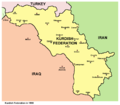8th–19th century states

Prior to the Ayyubid dynasty (until 1171)
- Hadhbanis (906–1144)
- Principality of Shaykhan (906–1832)
- Aishanids (912–961) [3]
- Daysam's Adharbayjan (938–955) [4]
- Shaddadids (951–1199) [5]
- Rawwadids (955–1071)
- Hasanwayhids (959–1014) [6]
- Marwanids (983–1096) [5]
- Annazids (990/91 [7] [8] –1117) [7]
- Shabankara (11th century–12th century) [9] [10]
- Principality of Eğil (1049–1864) [11]
- Atabegete of Greater Lorestan (1115–1425)
- Zakarids (1161–1360) [12] [13] [14]
- Ayyubid dynasty (1171–1341) [15]
After the Ayyubid dynasty (after 1171)
- Emirate of Kilis (1181/1183–1610) [16]
- Principality of Bitlis (1187–1847)
- Emirate of Şirvan (?–1840s) [17]
- Emirate of Çemişgezek (13th century–1663) [18]
- Principality of Donboli (1210–1799) [19]
- Emirate of Bingöl (1231–1864) [20]
- Emirate of Hasankeyf (1232 [20] –1524 [20] )
- Mukriyan (14th century–19th century) [21]
- Vassaldom of Ardalan (14th century [22] –1865 or 1868 [23] [24] )
- Principality of Zirqan (1335–1835)
- Emirate of Bahdinan (1339 [25] –1843 [26] )
- Emirate of Hakkâri (Before 1380s–1845) [27]
- Principality of Suleyman [28] (15th century–1838)
- Principality of Mahmudi (1406–1839) [29]
- Zarrinnaal Dynasty (1448–1925)
- Emirate of Palu (1495–1845) [30]
- Emirate of Pazooka (1499–1587) [31]
16th century onwards
- Baban (16th century–1850) [32]
- Emirate of Bradost (1510–1609) [33]
- Zafaranlu principality (1600-1922)
- Emirate of Bohtan (before 1514–1847) [34]
- Emirate of Soran (before 1514 [35] –1836 [36] )
- Principality of Pinyaşi (1548–1823) [37]
- Sarab Khanate (18th century) [38]
- Zand dynasty (1750–1794) – The dynasty is of Kurdish Lak origin. [39] [40]
- Tabriz Khanate (1757–1799) [38]
- Hasan Khan dynasty in Pish-e Kuh (1795–1820) [41]
- Emirate of Miks (?–1846) [42]







